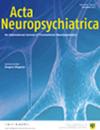Distributed Genetic Effects of the Corpus Callosum Subregions Suggest Links to Neuropsychiatric Disorders and Related Traits
IF 2.5
4区 医学
Q1 Medicine
引用次数: 1
Abstract
Background: The corpus callosum (CC) is a brain structure with a high heritability and potential role in psychiatric disorders. However, the genetic architecture of the CC and the genetic link with psychiatric disorders remains largely unclear. We investigated the genetic architectures of the volume of the CC and its subregions, and the genetic overlap with psychiatric disorders. Methods: We applied multivariate GWAS to genetic and T1-weighted MRI data of 40,894 individuals from the UK Biobank, aiming to boost genetic discovery and to assess the pleiotropic effects across volumes of the five subregions of the CC (posterior, mid posterior, central, mid anterior and anterior) obtained by FreeSurfer 7.1. Multivariate GWAS was run combining all subregions, co-varying for relevant variables. Gene-set enrichment analyses were performed using MAGMA. Linkage disequilibrium score regression (LDSC) was used to determine SNP-based heritability of total CC volume and volumes of its subregions as well as their genetic correlations with relevant psychiatric traits. Results: We identified 70 independent loci with distributed effects across the five subregions of the CC (p < 5 x 10-8). Additionally, we identified 33 significant loci in the anterior subregion, 23 in the mid anterior, 29 in the central, 7 in the mid posterior and 56 in the posterior subregion. Gene-set analysis revealed 156 significant genes contributing to volume of the CC subregions (p < 2.6 x 10-6). LDSC estimated the heritability of CC to (h2SNP=0.38, SE=0.03), and subregions ranging from 0.22 (SE=0.02) to 0.37 (SE=0.03). We found significant genetic correlations of total CC volume with bipolar disorder (BD, rg=-0.09, SE=0.03; p=5.9 x 10-3) and drinks consumed per week (rg=-0.09, SE=0.02; p=4.8 x 10-4), and volume of the mid anterior subregion with BD (rg=-0.12, SE=0.02; p=2.5 x 10-4), major depressive disorder (rg=-0.12, SE=0.04; p=3.6 x 10-3), drinks consumed per week (rg=-0.13, SE=0.04; p=1.8 x 10-3) and cannabis use (rg=-0.09, SE=0.03; p=8.4 x 10-3). Conclusions: Our results demonstrate that the CC has a polygenic architecture implicating multiple genes, and show that CC subregion volumes are heritable. We found distinct genetic factors are involved in the development of anterior and posterior subregions, consistent with their divergent functional specialization. Significant genetic correlation between volumes of the CC and bipolar disorder, drinks per week, major depressive disorder and cannabis consumption subregion volumes with psychiatric traits is noteworthy and deserving of further investigation.胼胝体亚区的分布遗传效应表明与神经精神障碍和相关特征有关
背景:胼胝体(CC)是一种具有高遗传性的大脑结构,在精神疾病中具有潜在作用。然而,CC的遗传结构以及与精神疾病的遗传联系在很大程度上仍不清楚。我们研究了CC体积及其亚区的遗传结构,以及与精神疾病的遗传重叠。方法:我们将多变量GWAS应用于英国生物库40894名个体的遗传和T1加权MRI数据,旨在促进基因发现,并评估FreeSurfer 7.1获得的CC五个亚区(后部、中后部、中部、中前部和前部)体积的多效性效应。多变量GWAS结合所有子区域运行,相关变量共同变化。使用MAGMA进行基因集富集分析。连锁不平衡评分回归(LDSC)用于确定基于SNP的CC总体积及其亚区体积的遗传力,以及它们与相关精神特征的遗传相关性。结果:我们确定了70个独立的基因座,这些基因座在CC的五个亚区具有分布效应(p<5×10-8)。此外,我们在前部亚区确定了33个重要位点,23个在前部中部,29个在中部,7个在后部,56个在后部亚区。基因集分析显示,156个重要基因对CC亚区的体积有贡献(p<2.6 x 10-6)。LDSC估计CC的遗传力为(h2SNP=0.38,SE=0.03),亚区的遗传力范围为0.22(SE=0.02)至0.37(SE=0.03)。我们发现总CC容量与双相情感障碍(BD,rg=0.09,SE=0.03;p=5.9 x 10-3)和每周饮酒量(rg-0.09,SE=0.02;p=4.8 x 10-4)之间存在显著的遗传相关性,重度抑郁障碍(rg=0.12,SE=0.04;p=3.6 x 10-3)、每周饮酒量(rg=0.13,SE=0.4;p=1.8 x 10-3。结论:我们的结果表明CC具有涉及多个基因的多基因结构,并表明CC亚区体积是可遗传的。我们发现不同的遗传因素参与了前部和后部亚区的发育,这与它们不同的功能专门化一致。CC量和双相情感障碍、每周饮酒量、重度抑郁障碍和大麻消费亚区域量与精神特征之间存在显著的遗传相关性,值得注意,值得进一步研究。
本文章由计算机程序翻译,如有差异,请以英文原文为准。
求助全文
约1分钟内获得全文
求助全文
来源期刊

Acta Neuropsychiatrica
医学-精神病学
CiteScore
8.50
自引率
5.30%
发文量
30
审稿时长
6-12 weeks
期刊介绍:
Acta Neuropsychiatrica is an international journal focussing on translational neuropsychiatry. It publishes high-quality original research papers and reviews. The Journal''s scope specifically highlights the pathway from discovery to clinical applications, healthcare and global health that can be viewed broadly as the spectrum of work that marks the pathway from discovery to global health.
 求助内容:
求助内容: 应助结果提醒方式:
应助结果提醒方式:


